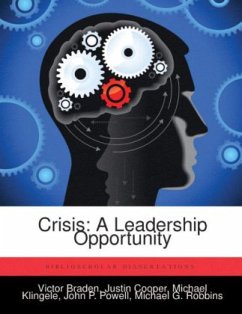For years crisis management has been synonymous with reactive leadership. This stems from a belief that crisis is both unpredictable and unexpected; but this is simply not true. Crisis develops as an organization's values, beliefs, culture, or behavior becomes incongruent with its operating environment. A leader, who is "tuned-in" to the signals of impending crisis and understands how to harness the urgency brought on by the situation, can minimize the potential dangers and maximize the resulting opportunities. This paper presents the "Crisis Lifecycle Model" as a generic representation of crisis. It illustrates that crisis can be broken into three unique phases. In the first or preparation phase, the organization is typically mired in the comfort zone. Here, leaders struggle when introducing any change or learning, as the organization prefers to avoid conflict and sustain equilibrium. However, as crisis hits, the organization is jolted into the emergency phase, often threatening its very existence. Once the immediate threat is eliminated, the organization enters the adaptive phase. In this phase, the leader has the attention and urgency to solve the underlying issue that caused the crisis in the first place. Unfortunately, many leaders don't take advantage of this opportunity and push the organization back toward the original status-quo, ensuring that the crisis will return. The study of crisis leadership is becoming increasingly important as leaders in all walks of life face varying degrees of crisis, spawning numerous recent books and articles. From this extensive body of work, we found seven essential strategies that are crucial for success. They are to: Lead from the Front, Focus on the Core Purpose, Build the Team, Conduct Continuous Planning, Mitigate the Threat, Tell the Story, and Profit from the Crisis.
Hinweis: Dieser Artikel kann nur an eine deutsche Lieferadresse ausgeliefert werden.
Hinweis: Dieser Artikel kann nur an eine deutsche Lieferadresse ausgeliefert werden.








